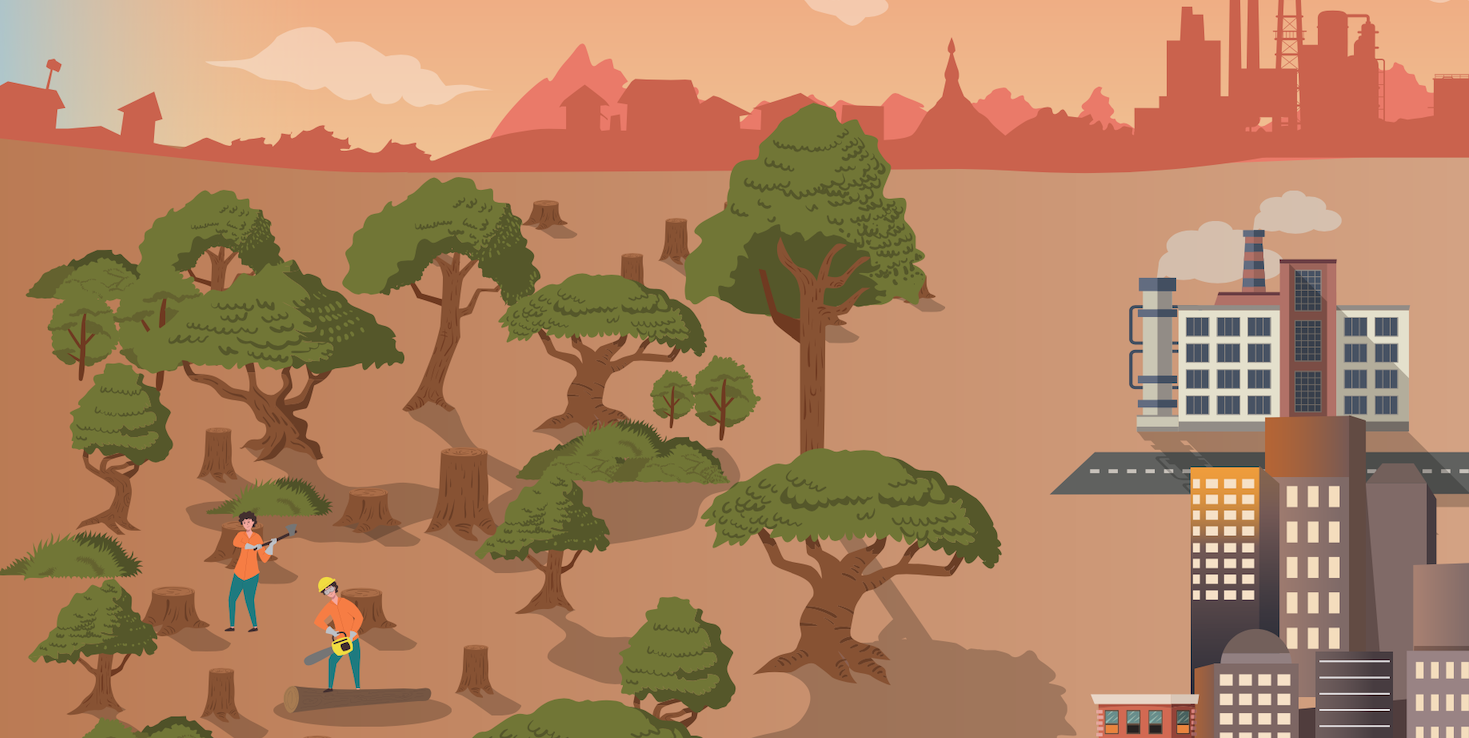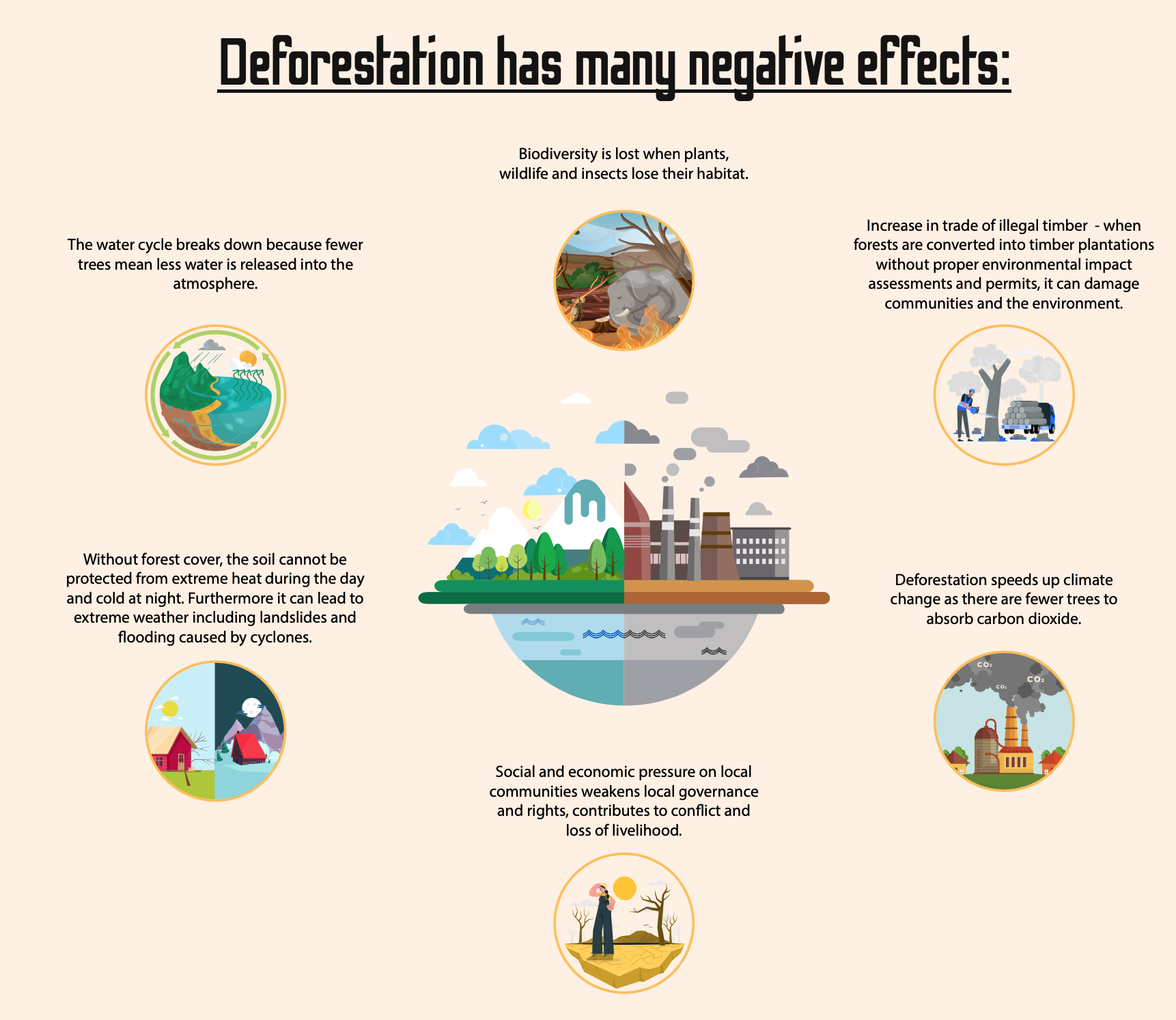
Deforestation and impacts on our health and nature
Myanmar retains some of the largest remaining areas of contiguous rainforest in Southeast Asia, hosting some of the most vulnerable species. However, deforestation rates are one of the highest in the world.
What is deforestation?
Deforestation is the curling or cutting down of forests, clearing lands and their related ecosystems to use for other anthropogenic purposes, often agricultural (growing crops like palm oil or creating pasture for cattles), but also for urban and infrastructure development or mining. Deforestation is being done by businesses and individuals for economic reasons, or simply for survival. In Myanmar, 70% of the population lives in rural areas and depends on forest products.
Myanmar’s forests are being cleared primarily for large-scale agriculture, logging and infrastructure. This is known as forest conversion, and it is the leading cause of deforestation in Myanmar.

From 2010 to 2016, Myanmar lost an average of half a million hectares a year. Despite attempts by local communities to control and protect their resources, armed conflict and development projects have only grown the environmental devastation.
What issues result from deforestation for humans and wildlife?

What causes deforestation?
The main causes of deforestation are caused by the demand for land to make room for human settlements including houses, roads and other transports, or to produce commodities such as agricultural products, timber, charcoal/fuelwood, and mineral resources.
Deforestation is high, and it is a growing concern in many tropical conflict-affected and post-conflict countries.
- Colombia - In 2020, there was an increase of 34,000 ha of tree cover loss causing not only a disruption in Colombia’s functioning ecosystems but increased poverty, unequal access to land and water, and increased health problems due to exposure from contaminants, like mercury, due to increased artisanal mining.
- Cambodia - Between 2001 and 2018, Cambodia lost 557,000 ha of tree cover in protected areas (a loss of 11% of total protected areas). Deforestation has resulted in the destruction of forest ecosystems and in social and economic losses for the indigenous people and local communities depending on forests.
What are the risks ofthe timber coming from deforestation being illegal?
Deforestation and forest conversion can also result in illegal timber contravening national laws. Between 2017 and 2020, efforts were made to limit all sales of logs to auctions and ban exports of products from conversion forests and conflict areas. Furthermore, determining the (il)legality is difficult due to the weak supervision of the national guidelines and standards for timber legality throughout the supply chain that ensures the product's sustainability and compliance with social, human rights and environmental standards.
There have been investigations into European and US companies that have contravened EU and US laws to obtain illicit timber and avoid tax. It is estimated that since 2021, timber exports from Myanmar generated a revenue of more than
$106 million.
5 steps to prevent and reduce deforestation

References
Treue, T., Springate-Baginski, O., and Htun, K. 2016. Legally and Illegally Logged out: Extent and Drivers of Deforestation & Forest Degradation in Myanmar.
FAO. 2020. Global Forest Resources Assessment 2020 – Key findings. Rome https://www.fao.org/redd/news/detail/en/c/1259388/
Hansen, M. C., Potapov, P. V., Moore, R., Hancher, M., Turubanova, S. A., Tyukavina, A., ... & Townshend, J. (2013). High-resolution global maps of 21st-century forest cover change. science, 342(6160), 850-853. Observatorio Do Clima (2022). The bill has come due. The third year of environmental havoc under Jair Bolzona- ro.
Betancur-Alarcón, L., & Krause, T. (2020). Reaching for the mountains at the end of a Rebelocracy: Changes in land and water access in Colombia's highlands during the post-peace agreement phase. Frontiers in Environmen- tal Science, 205.
Vélez-Torres, I., Vanegas, D. C., McLamore, E. S., & Hurtado, D. (2018). Mercury Pollution and Artisanal Gold Mining in Alto Cauca, Colombia: Woman’s Perception of Health and Environmental Impacts. The Journal of Environment & Development, 27(4), 415–444.
https://southeastasiaglobe.com/vietnams-worst-flooding-for-decades/
IPCC, 2018: Global Warming of 1.5°C.An IPCC Special Report on the impacts of global warming of 1.5°C above pre-industrial levels and related global greenhouse gas emission pathways, in the context of strengthening the global response to the threat of climate change, sustainable development, and efforts to eradicate poverty
https://www.globalforestwatch.org/blog/data-and-research/whats-happening-in-cambodias-forests/ https://eia-international.org/report/taxing-questions-evidence-of-tax-evasion-in-teak-exports-from-myanmar/ https://www.icij.org/investigations/deforestation-inc/myanmar-teak-trade-sanctions-military-regime/



